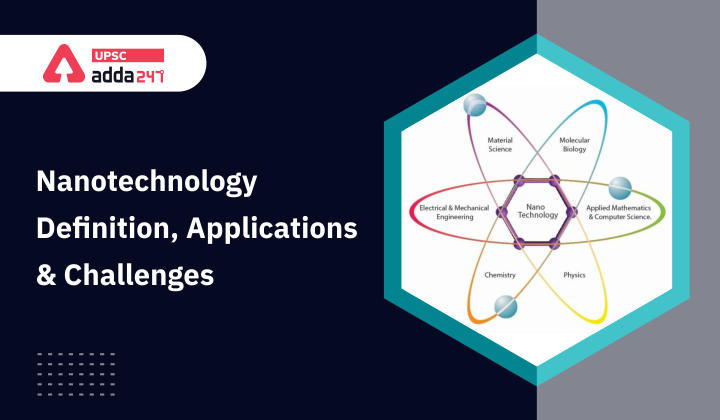Table of Contents
UPSC has been continuously asking question from emerging technologies like biotechnology, nanotechnology, among others. In this article, we will discuss about nanotechnologies and all its related aspects that are important for the UPSC civil services examination, in both its phases—prelims and mains.
Nanotechnology definition
- Nanotechnology is the understanding and control of matter at the nanoscale, where unique phenomena enable novel applications.
- Special high-powered microscopes have been developed to allow scientists to see and manipulate nanoscale materials.
- Nanoscale: Dimensions between approximately 1 and 100 nanometers are called as the nanoscale.
- Nanometer: A nanometer is one-billionth of a meter. It is small that special high-powered microscopes have been developed to allow scientists to see and manipulate nanoscale materials.
Nanotechnology applications
Nanotechnology and nanomaterials can be applied in all kinds of industrial sectors. Below are few of the applications of nanotechnology:
Everyday Materials and Processes
- Nanoscale additives to fabrics can provide lightweight ballistic energy deflection in personal body armor, or can help them resist wrinkling, staining, and bacterial growth.
- Clear nanoscale films on eyeglasses, computer and camera displays, windows, and other surfaces can make them water- and residue-repellent, antireflective, self-cleaning, resistant to ultraviolet or infrared light, antifog, antimicrobial, scratch-resistant, or electrically conductive.
- Nanoscale materials are beginning to enable washable, durable “smart fabrics” equipped with flexible nanoscale sensors and electronics with capabilities for health monitoring, solar energy capture, and energy harvesting through movement.

Electronics and IT Applications
- Ultra-high-definition displays and televisions are now being sold that use quantum dots to produce more vibrant colors while being more energy efficient.
- Flexible, bendable, foldable, rollable, and stretchable electronics are reaching into various sectors and are being integrated into a variety of products, including wearables, medical applications, aerospace applications, and the Internet of Things.
Medical and Healthcare Applications
- Better imaging and diagnostic tools enabled by nanotechnology are paving the way for earlier diagnosis, more individualized treatment options, and better therapeutic success rates.
- Nanotechnology is being studied for both the diagnosis and treatment of atherosclerosis, or the buildup of plaque in arteries.
- Research in the use of nanotechnology for regenerative medicine spans several application areas, including bone and neural tissue engineering.
Energy Applications
- Nanotechnology is improving the efficiency of fuel production from raw petroleum materials through better catalysis. It is also enabling reduced fuel consumption in vehicles and power plants through higher-efficiency combustion and decreased friction.
- Nanotechnology is also being applied to oil and gas extraction through, for example, the use of nanotechnology-enabled gas lift valves in offshore operations.
- Nanotechnology can be incorporated into solar panels to convert sunlight to electricity more efficiently, promising inexpensive solar power in the future.
Environmental Remediation
- Nanotechnology could help meet the need for affordable, clean drinking water through rapid, low-cost detection and treatment of impurities in water.
- Researchers have developed a nanofabric “paper towel” woven from tiny wires of potassium manganese oxide that can absorb 20 times its weight in oil for cleanup applications.
Future Transportation Benefits
- As discussed above, nano-engineered materials in automotive products include,
- polymer nanocomposites structural parts;
- high-power rechargeable battery systems;
- thermoelectric materials for temperature control;
- lower rolling-resistance tires;
- high-efficiency/low-cost sensors and electronics; and
- thin-film smart solar panels;
Nanotechnology Challenges
- Stability of nanoclusters and surface reconstruction.
- Thermal noise, Brownian motion and tolerance.
- Friction and energy dissipation.
- Design for a motor.
- The eutactic environment and the feed-through problem.
Also Read:




 TSPSC Group 1 Question Paper 2024, Downl...
TSPSC Group 1 Question Paper 2024, Downl...
 TSPSC Group 1 Answer key 2024 Out, Downl...
TSPSC Group 1 Answer key 2024 Out, Downl...
 UPSC Prelims 2024 Question Paper, Downlo...
UPSC Prelims 2024 Question Paper, Downlo...
